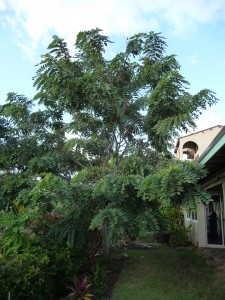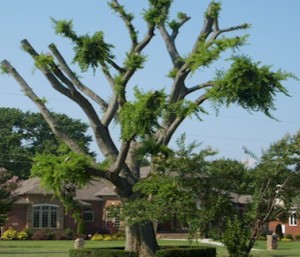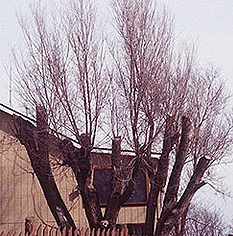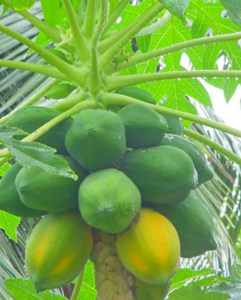
The Shower Tree, after 25% of the canopy had been trimmed by arborist Tai Dormen of Alihilani Arborcare.
After twenty-five years of reading about, and wanting, renewable energy for my own home, the day had finally come. The photovoltaic panels were cheaper, the rebates make the system affordable, and I live in a place that is sunny 360 days out of the year.
There was just one little hitch: shading one part of my roof was a beautiful “Rainbow” Shower Tree.
I called an arborist friend to help me figure out how to trim the tree to clear the roof and still preserve its structural integrity and beauty. My friend has a way of studying a tree, tracing its branching patterns, and figuring out how to make the fewest cuts to achieve the desired effect. We came up with a plan, and I was able to find another arborist who had time and a crew to do the work: Tai Dormen of Alihilani Arborcare. To my great delight, he improved upon our original plan, and the tree is now trimmed. Though Tai removed a significant portion of the canopy, it still looks full, casts shade on the house in the right places, and is clear of the sunpath for the PV panels. Everyone is happy, especially the tree.
As a landscape designer, I quickly learned the difference between “tree trimmers” and certified arborists. Tree trimmers are responsible for most of the chop jobs seen in every urban and suburban community. People hire them because they are cheaper than arborists. But I tell my clients, “If you want to keep the tree, don’t let anyone other than an arborist touch it.”

This tree has been topped. It will never be the same.
Once I had a client for whom I was doing a complete renovation. There was a magnolia in her backyard that had become densely overgrown. I called in an arborist who estimated $800 to do a renovation pruning. The tree was going to be the centerpiece of the backyard, and I could tell from the branches that it had good form underneath. But my client mentioned to the landscape contractor who was installing the gravel and flagstone patio that she needed the tree trimmed, and he offered to do it for free. Of course, she quickly took him up on it. Afterwards, she called me and said, “Susan, I’m calling to let you know that I didn’t listen, and I wanted to warn you. I just want to cry every time I look at it. It’s just awful.” And it wasawful. She got what she paid for.
Topping a tree to “cut it back” ignores the natural growth patterns and structure of the tree. When topped, trees put out weak, multiple sprouts just below the cut. This makes the tree denser than it would be naturally, and those sprouts do not have the structural strength to hold their own weight as they grow out. Once topped, a tree has to be retopped regularly to keep it from becoming overly dense and dangerous. The tree becomes addicted to frequent trimming.

A topped tree puts out many weak branches that will require it to be trimmed frequently.
A good structural pruning, on the other hand, often last two or three years– longer if the tree has room to grow. So, in the end, a certified arborist saves you money, and you have a more beautiful tree.
And what if your tree needs pruning because it is too big for its space, or causes problems with views or other issues? The problem originated when someone chose a tree that was inappropriate for the space. I see this all the time when clients or landscapers plant a 4′ sapling in a narrow or short space, forgetting that someday it will become a 20′ tree. As the Plant Amnesty guru and founder, Cass Turnbull says, don’t be fooled by the diminutive size of the tree when you buy it: “They call it a ‘nursery’ because they’re just babies.”
Clients sometimes think I’m heartless to suggest removing a living tree or shrub. But it is better to remove the tree or shrub and plant something that will grow to the proper size and height than continually torture the plant into a size it was never meant to be. Here in Hawaii, Hibiscus shrubs are a case in point. Most Hibiscus hedges are trimmed back relentlessly to keep them 4-6′ in height. But most varieties grow naturally from 8′ to 12′, and they flower on the ends. Trimming them constantly not only stresses the plants and increases their likelihood of developing disfiguring diseases, but it removes most of the flowers. So people are planting Hibiscus and then turning them into nasty short green hedges with an occasional flower. This makes no sense.
Which takes us back to the issue of tree trimmers versus arborists. Tree trimmers make a living because people consistently put the wrong-sized plants under electrical wires, next to buildings, and in places that require constant trimming. That creates an ongoing problem that costs a lot of maintenance money. Tree trimming forces plants to increase their growth rate to make up for the leaf canopy that was lost. So you spend more to keep trimming the trees back.
Arborists can work magic on a tree, but they can’t resolve that underlying issue of wrong-sized tree, except to tell you to take the tree out and replant with an appropriate-sized specimen. Cass Turnbull adds one other reason not to plant the wrong-sized tree and then use cheap tree-topping methods to keep it to size: “It makes you look bad.”
So do your pocketbook, your image, and your tree a favor: Plant wisely and hire an arborist!



